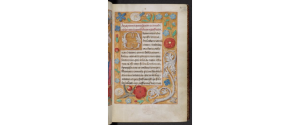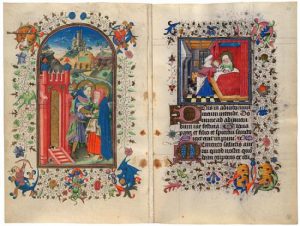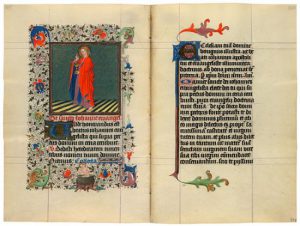I’m interested here in exploring the meaning behind the seemingly random collection of images that inhabit the borders of books of hours. Miniatures, though often equally bizarre to modern eyes, are easier to contextualize—they narrate, are illustrative, meditative companions to the text. Margins, or borders, supplement.
Often these supplements are logical and straightforward. Calendar folios are filled with images of the labor of the month, the appropriate astrological symbol, and children playing in seasonally appropriate games. Margins of psalms and prayers can contain decorative imagery, as well as symbols.
Leafing through the folios of the Hours of Anne Boleyn, (British Library Kings MS 9) I was struck by a kind of femininity in its scatterborders. Perhaps that was the source of much of the confusing images? The lovely illuminated margins in this manuscript were colored pink and detailed with elegant peacocks and blossoming peonies. Given books of hours were often the property of women, I wondered if these images were created with these owners in mind, but further research showed this was probably false.

The items I took for granted as feminine, rosy colors and flowers and birds, are appropriated such in a twenty-first century context. In a medieval setting, these were a fixture of their decoration, no femininity about it. As Elizabeth Schaeffer explains in “Time & the Flower”, many floral images in the Hours of Catherine of Cleves are used in the Hours of the Virgin and the Hours of the Cross as direct symbols of the life of Mary and Christ. Alternatively, as the title of her essay suggests, these flowers represent the temporality of the seasons in each blossom’s variety. [1]
However, this failed inquiry led me to explore the Hours of Catherine of Cleves, Pierpont Morgan Library. MS M.917, which led to some bizarre material. Amidst its vibrant, rinceaux borders, The Hours of Catherine of Cleves flagrantly demonstrates such oddities in this highly decorated manuscript. Much could be interpreted with the text; much defies reason.

A lot of the more creative images could be explained by the Franco-Flemish tradition of fatrastie, images from amusing courtly poetry that defied reason. [2] Demons and a chicken waving a flag sit beside each other on f. 1v. Monsters pervade, beehives guzzle honey on f 20r. Infants play in a chicken yard of f 32r. There are half humans abound f 47v. However, we may have an explanation for the demon monkey cooking in f 83 v. Camille explains apes in particular, pervade medieval art, being a common symbol of “the dubious status of representation itself”, or the “danger of mimesis or illusion in God’s created scheme of things.” (Camille 13)

Though I could not tell you why it was cooking, nor why later there is a child being cooked in a cauldron. (pp. 218)
The unusualness of these images is interesting to note, in context, because they are quite literally marginalized. Borders are ephemeral, “marginalized”, existential, and symbolic. From Study of Marginal Imagery: “If on the one hand marginal images refer to the real world, equally characteristic of marginalia is the tremendous abundance, variety, and inventiveness of images that are physically abnormal and “real” primarily in the imagination.” (23) Thus by literally inhabiting the outside of the text, it simultaneously acts outside the realms of reality. And yet in this ethereal state, borders can still relate real world to content, like in calendar images. But of more interest are the “monsters, grotesques, hybrids, drolleries, babewyns” and “chimeras, mermaids, griffins, grylli, marvels of the east” that grace our pages. As Camille says of the image on the edge “the butterfly juxtaposed with a cooking pot in the right margin of the opposite page might remind modern observers of the Surrealists pleasure in the ‘fortuitous meeting of a sewing machine and an umbrella on an operating table’. But whereas modern artists such as Magritte or Ernst juxtaposed banal fragments of the real world as ominous fetishes, the exquisite incongruity of medieval marginal art refuses us the illusion of a dream.” (Camille 12)
These borders are filled with the juxtaposition of the fantastic and the grotesque of medieval oddities that truly is reminiscent of a later painter from the same region, Hieronymus Bosch. [3]
After all the fun we’ve had with the bizarre, let’s remember the Hours of Anne’s realist illuminations. Being made more than a century after the Hours of Catherine of Cleves (ca 1435-60), and in an entirely different region, it’s understandable there’s been a departure in taste and style, moving from the extraordinary monsters to the botanical certainty. But between time and space, how do these trends change the relationship between the borders and their text? Anne Boleyn’s Hours lovely flowers and birds strike a note of realism, while Catherine of Cleves walks the line of real and sublime. On the subject of realism, humor me: these are relative terms, create a whole subset of the imagination. No creative work can be entirely “realist”, but as close to real as a reproduction can be made. Take the Platonic ideal of the work, while all created is the imperfect reflection of the text. Here, the image can act as a reflection of the text (both the content of the manuscript and the Platonic text) and the actual natural image it is drawn from. Thus in a philosophical sense, these real, less absurd illuminations still operates on the edge of reality, but within a more complacent form.
Of course, if this seems kind of stretch, this change could be due to the creation of mass produced Books of Hours in the 15th century. With this change, works were less tailored to their patrons, and created with the intent of a broad audience. The artistic trend of the 15c natural illuminations could entirely change the relationship of the center and the margin. No longer the reader’s (and illuminator’s) lingering marginality of the subconscious, the margins operate on the outskirts to elucidate the reader’s comprehension, with clear, concise, recognizable images to demonstrate the trajectory of the text, such as Schaeffer’s explanation of flowers.
Much of these borders can be contextualized and explained away. Much can be described as decorative, enjoyed, and forgotten. But much reason to these has fallen through time, or perhaps never existed in the first place. Which leads us now to the exciting prospect of the “marginalization” of images, subverted graphics which seep into the pious mind during meditation, and befuddle the modern reader.
[1] Schaeffer, Elizabeth. “Time & Flower: Significant Images of the Passage of Time in the Floral Borders of the Hours of Catherine of Cleves.” (1987) .Master Theses. Paper 1271.
[2] Camille, Michael. “Image on the Edge: the Margins of Medieval Art.” Art Documentation: Journal of the Art Libraries Society of North America, 11.4, 1992, 10-55.
[3] Gerrittsen, William Peter. “Meditation Memory Margins in Hours of Catherine of Cleves.” Manuscpten en miniature : studies aangeboden aan Anne S. Korteweg bij haar afscheid van de Koninlijke Bibliotheek, 2007, 91-100.